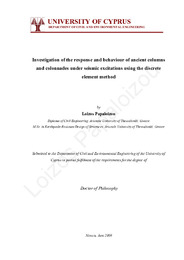Investigation of the response and behaviour of ancient columns and colonnades under seismic excitations using the discrete element method
Date
2009-05Author
Papaloizou, LoizosPublisher
Πανεπιστήμιο Κύπρου, Πολυτεχνική Σχολή / University of Cyprus, Faculty of EngineeringPlace of publication
CyprusGoogle Scholar check
Keyword(s):
Metadata
Show full item recordAbstract
Η διερεύνηση της σεισμικής συμπεριφοράς αρχαίων μνημειακών κατασκευών με σπονδυλωτούς κίονες παρουσιάζει μεγάλο επιστημονικό ενδιαφέρον αφού η απόκρισή τους περιέχει εξαιρετικά σύνθετα φαινόμενα λικνισμού και ολισθήσεων. Επειδή ο υπολογισμός με αναλυτικές λύσεις τέτοιων συστημάτων υπό σεισμικές διεγέρσεις είναι πρακτικά αδύνατος, χρησιμοποιούνται κατάλληλες αριθμητικές μέθοδοι για την προσομοίωση τους. Για το σκοπό αυτό έχει αναπτυχθεί εξειδικευμένο λογισμικό, υλοποιώντας τη Μέθοδο των Διακριτών Στοιχείων (ΜΔΣ), το οποίο παρέχει τη δυνατότητα προσομοίωσης διακριτών στερεών σωμάτων υπό αρμονικές και σεισμικές διεγέρσεις, καθώς και εκτέλεσης σχετικών παραμετρικών αναλύσεων. Για την ανάπτυξη του λογισμικού χρησιμοποιήθηκε μία σύγχρονη γλώσσα αντικειμενοστραφούς προγραμματισμού, βελτιστοποιώντας αλγόριθμους επαφής και διάφορα σχεδιαστικά πρότυπα ανάπτυξης λογισμικού για το συγκεκριμένο πρόβλημα. Για την επαλήθευση της ορθότητας του λογισμικού που αναπτύχθηκε γίνεται σύγκριση των αποτελεσμάτων του, με αντίστοιχα αποτελέσματα αναλυτικών λύσεων απλοποιημένων προβλημάτων καθώς και με πειραματικές μετρήσεις. Με αυτό το λογισμικό έχει πραγματοποιηθεί σημαντικός αριθμός παραμετρικών αναλύσεων για να διερευνηθεί η επίδραση των χαρακτηριστικών της διέγερσης, καθώς και των γεωμετρικών και μηχανικών χαρακτηριστικών σπονδυλωτών κιόνων και κιονοστοιχιών στη συμπεριφορά και απόκρισή τους υπό αρμονικές και σεισμικές διεγέρσεις. Εξετάζονται διάφορες παράμετροι της επιβαλλόμενης κίνησης της βάσης καθώς και παράμετροι που αφορούν τα μηχανικά και γεωμετρικά χαρακτηριστικά των προσομοιούμενων κατασκευών. Strong earthquakes are common causes of destruction of ancient monuments, such as classical columns and colonnades. Ancient columns of great archaeological significance can be found in high seismicity areas in the Eastern Mediterranean. The understanding of the behaviour and response of these valuable structures during strong earthquakes is useful for the assessment of conservation and rehabilitation proposals for such structures. The seismic behaviour of ancient columns and colonnades involves complicated rocking and sliding phenomena that very rarely appear in modern structures. The analytical study of such multi-block structures under strong earthquake excitations is extremely complicated if not impossible. Computational methods can be used to simulate the dynamic behaviour and seismic response of these structures. The discrete element method (DEM) is utilized to investigate the response of ancient multi-drum columns and colonnades during harmonic and earthquake excitations by simulating the individual rock blocks as distinct rigid bodies. A specialized software application has been designed and developed, using modern object-oriented technologies and computer graphics to perform efficient seismic simulations of multi-block structures. The developed software is thoroughly validated by comparing the computed responses of various fundamental problems, such as sliding, rocking and free vibration dynamics of rigid bodies, with corresponding analytical solutions as well as results obtained from experiments that are available in the literature. A large number of parametric simulations of multi-drum columns and colonnades, as well as colonnade systems with two rows of columns, the one on top of the other, have been conducted in order to investigate and understand the influence of different characteristics of earthquake excitations as well as various mechanical and geometrical characteristics of these structures on their seismic response. Parametric studies have been performed by varying the excitation frequency and acceleration, as well as the friction coefficient and the geometric characteristics of the simulated columns and colonnades in order to assess the influence of these parameters in their seismic response and behaviour.

